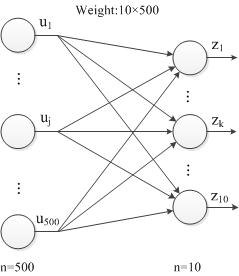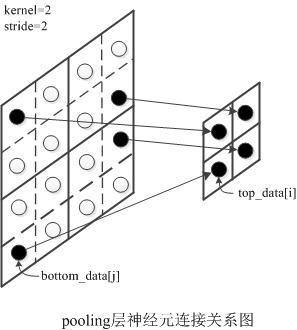本文地址:http://blog.csdn.net/mounty_fsc/article/details/51379395
本部分剖析Caffe中Net::Backward()函数,即反向传播计算过程。从LeNet网络角度出发,且调试网络为训练网络,共9层网络。具体网络层信息见 (Caffe,LeNet)初始化训练网络(三) 第2部分
本部分不介绍反向传播算法的理论原理,以下介绍基于对反向传播算法有一定的了解。
1 入口信息
Net::Backward()函数中调用BackwardFromTo函数,从网络最后一层到网络第一层反向调用每个网络层的Backward。
void Net<Dtype>::BackwardFromTo(int start, int end) {
for (int i = start; i >= end; --i) {
if (layer_need_backward_[i]) {
layers_[i]->Backward(
top_vecs_[i], bottom_need_backward_[i], bottom_vecs_[i]);
if (debug_info_) { BackwardDebugInfo(i); }
}
}
}2 第九层SoftmaxWithLossLayer
2.1 代码分析
代码实现如下:
void SoftmaxWithLossLayer<Dtype>::Backward_gpu(const vector<Blob<Dtype>*>& top,
const vector<bool>& propagate_down, const vector<Blob<Dtype>*>& bottom) {
// bottom_diff shape:64*10
Dtype* bottom_diff = bottom[0]->mutable_gpu_diff();
// prob_data shape:64*10
const Dtype* prob_data = prob_.gpu_data();
// top_data shape:(1)
const Dtype* top_data = top[0]->gpu_data();
// 将Softmax层预测的结果prob复制到bottom_diff中
caffe_gpu_memcpy(prob_.count() * sizeof(Dtype), prob_data, bottom_diff);
// label shape:64*1
const Dtype* label = bottom[1]->gpu_data();
// dim = 640 / 64 = 10
const int dim = prob_.count() / outer_num_;
// nthreads = 64 / 1 = 64
const int nthreads = outer_num_ * inner_num_;
// Since this memory is never used for anything else,
// we use to to avoid allocating new GPU memory.
Dtype* counts = prob_.mutable_gpu_diff();
// 该函数将bottom_diff(此时为每个类的预测概率)对应的正确类别(label)的概率值-1,其他数据没变。见公式推导。
SoftmaxLossBackwardGPU<Dtype><<<CAFFE_GET_BLOCKS(nthreads),
CAFFE_CUDA_NUM_THREADS>>>(nthreads, top_data, label, bottom_diff,
outer_num_, dim, inner_num_, has_ignore_label_, ignore_label_, counts);
// 代码展开开始,代码有修改
__global__ void SoftmaxLossBackwardGPU(...) {
CUDA_KERNEL_LOOP(index, nthreads) {
const int label_value = static_cast<int>(label[index]);
bottom_diff[index * dim + label_value] -= 1;
counts[index] = 1;
}
}
// 代码展开结束
Dtype valid_count = -1;
// 注意为loss的权值,对该权值(一般为1或者0)归一化(除以64)
// Scale gradient
const Dtype loss_weight = top[0]->cpu_diff()[0];
if (normalize_) {
caffe_scal(prob_.count(), loss_weight / count, bottom_diff);
} else {
caffe_scal(prob_.count(), loss_weight / outer_num_, bottom_diff);
}
}说明:
1. SoftmaxWithLossLayer是没有学习参数的(见前向计算(五)) ,因此不需要对该层的参数做调整,只需要计算bottom_diff(理解反向传播算法的链式求导,求bottom_diff对上一层的输出求导,是为了进一步计算调整上一层权值)
2. 以上代码核心部分在SoftmaxLossBackwardGPU。该函数将bottom_diff(此时为每个类的预测概率)对应的正确类别(label)的概率值-1,其他数据没变。这里使用前几节的符号系统及图片进行解释。
2.2 公式推导
符号系统
设SoftmaxWithLoss层的输入为向量 z ,即bottom_blob_data,也就是上一层的输出。经过Softmax计算后的输出为向量 f(z) ,公式为(省略了标准化常量m) f(zk)=ezk∑niezi 。最后SoftmaxWithLoss层的输出为 loss=∑n−logf(zy) , y 为样本的标签。见前向计算(五)。
反向推导
把loss展开可得
loss=log∑inezi−zy
所以 dlossdz 结果如下:
∂loss∂zi={f(zy)−1,zi=zyf(zi),zi≠zy图示
3 第八层InnerProduct
3.1 代码分析
template <typename Dtype>
void InnerProductLayer<Dtype>::Backward_gpu(const vector<Blob<Dtype>*>& top,
const vector<bool>& propagate_down,
const vector<Blob<Dtype>*>& bottom) {
//对参数求偏导,top_diff*bottom_data=blobs_diff
// 注意,此处(Dtype)1., this->blobs_[0]->mutable_gpu_diff()
// 中的(Dtype)1.:使得在一个solver的iteration中的多个iter_size
// 的梯度没有清零,而得以累加
if (this->param_propagate_down_[0]) {
const Dtype* top_diff = top[0]->gpu_diff();
const Dtype* bottom_data = bottom[0]->gpu_data();
// Gradient with respect to weight
caffe_gpu_gemm<Dtype>(CblasTrans, CblasNoTrans, N_, K_, M_, (Dtype)1.,
top_diff, bottom_data, (Dtype)1., this->blobs_[0]->mutable_gpu_diff());
}
// 对偏置求偏导top_diff*bias=blobs_diff
if (bias_term_ && this->param_propagate_down_[1]) {
const Dtype* top_diff = top[0]->gpu_diff();
// Gradient with respect to bias
caffe_gpu_gemv<Dtype>(CblasTrans, M_, N_, (Dtype)1., top_diff,
bias_multiplier_.gpu_data(), (Dtype)1.,
this->blobs_[1]->mutable_gpu_diff());
}
//对上一层输出求偏导top_diff*blobs_data=bottom_diff
if (propagate_down[0]) {
const Dtype* top_diff = top[0]->gpu_diff();
// Gradient with respect to bottom data
caffe_gpu_gemm<Dtype>(CblasNoTrans, CblasNoTrans, M_, K_, N_, (Dtype)1.,
top_diff, this->blobs_[0]->gpu_data(), (Dtype)0.,
bottom[0]->mutable_gpu_diff());
}
}
3.2 公式推导
如图,当前层ip2层的输入为 z ,上一层的输入为 u 。
1. 对上一层输出求偏导
∂loss∂uj 存放在ip2层的bottom_blob_diff(64*500)中,计算公式如下,其中 ∂loss∂zk 存放在top_blob_diff(64*10)中:
写成向量的形式为:
进一步,写成矩阵的形式,其中 u 为500维, z 为10维, W 为 10×500 :
再进一步,考虑到一个batch有64个样本,表达式可以写成如下形式,其中 U 为 64×500 ; Z 为 64×10 ; W 为 10×500 :
2. 对参数求偏导
写成向量的形式有:
进一步,可以写成矩阵形式,其中 W 为 10×500 ; z 为10维; u 为500维。
再进一步,考虑到一个batch有64个样本,表达式可以写成如下形式,其中 W 为 10×500 ; Z 为 64×10 ; U 为 64×500 :

4 第七层ReLU
4.1 代码分析
cpu代码分析如下,注,该层没有参数,只需对输入求导
void ReLULayer<Dtype>::Backward_cpu(const vector<Blob<Dtype>*>& top,
const vector<bool>& propagate_down,
const vector<Blob<Dtype>*>& bottom) {
if (propagate_down[0]) {
const Dtype* bottom_data = bottom[0]->cpu_data();
const Dtype* top_diff = top[0]->cpu_diff();
Dtype* bottom_diff = bottom[0]->mutable_cpu_diff();
const int count = bottom[0]->count();
//见公式推导
Dtype negative_slope = this->layer_param_.relu_param().negative_slope();
for (int i = 0; i < count; ++i) {
bottom_diff[i] = top_diff[i] * ((bottom_data[i] > 0)
+ negative_slope * (bottom_data[i] <= 0));
}
}
}
4.2 公式推导
设输入向量为
bottom_data
,输出向量为
top_data
,ReLU层公式为
5 第五层Pooling
5.1 代码分析
Maxpooling的cpu代码分析如下,注,该层没有参数,只需对输入求导
void PoolingLayer<Dtype>::Backward_cpu(const vector<Blob<Dtype>*>& top,
const vector<bool>& propagate_down, const vector<Blob<Dtype>*>& bottom) {
const Dtype* top_diff = top[0]->cpu_diff();
Dtype* bottom_diff = bottom[0]->mutable_cpu_diff();
// bottom_diff初始化置0
caffe_set(bottom[0]->count(), Dtype(0), bottom_diff);
const int* mask = NULL; // suppress warnings about uninitialized variables
...
// 在前向计算时max_idx中保存了top_data中的点是有bottom_data中的点得来的在该feature map中的坐标
mask = max_idx_.cpu_data();
// 主循环,按(N,C,H,W)方式便利top_data中每个点
for (int n = 0; n < top[0]->num(); ++n) {
for (int c = 0; c < channels_; ++c) {
for (int ph = 0; ph < pooled_height_; ++ph) {
for (int pw = 0; pw < pooled_width_; ++pw) {
const int index = ph * pooled_width_ + pw;
const int bottom_index = mask[index];
// 见公式推导
bottom_diff[bottom_index] += top_diff[index];
}
}
bottom_diff += bottom[0]->offset(0, 1);
top_diff += top[0]->offset(0, 1);
mask += top[0]->offset(0, 1);
}
}
}5.2 公式推导
由图可知,maxpooling层是非线性变换,但有输入与输出的关系可线性表达为
bottom_dataj=top_datai
(所以需要前向计算时需要记录索引i到索引j的映射max_idx_.
链式求导有:
6 第四层Convolution
void ConvolutionLayer<Dtype>::Backward_cpu(const vector<Blob<Dtype>*>& top,
const vector<bool>& propagate_down, const vector<Blob<Dtype>*>& bottom) {
const Dtype* weight = this->blobs_[0]->cpu_data();
Dtype* weight_diff = this->blobs_[0]->mutable_cpu_diff();
for (int i = 0; i < top.size(); ++i) {
const Dtype* top_diff = top[i]->cpu_diff();
const Dtype* bottom_data = bottom[i]->cpu_data();
Dtype* bottom_diff = bottom[i]->mutable_cpu_diff();
// Bias gradient, if necessary.
if (this->bias_term_ && this->param_propagate_down_[1]) {
Dtype* bias_diff = this->blobs_[1]->mutable_cpu_diff();
// 对于每个Batch中的样本,计算偏置的偏导
for (int n = 0; n < this->num_; ++n) {
this->backward_cpu_bias(bias_diff, top_diff + n * this->top_dim_);
}
}
if (this->param_propagate_down_[0] || propagate_down[i]) {
// 对于每个Batch中的样本,关于权值及输入求导部分代码展开了函数(非可运行代码)
for (int n = 0; n < this->num_; ++n) {
// gradient w.r.t. weight. Note that we will accumulate diffs.
//top_diff(50*64) * bottom_data(500*64,Transpose) = weight_diff(50*500)
// 注意,此处(Dtype)1., this->blobs_[0]->mutable_gpu_diff()
// 中的(Dtype)1.:使得在一个solver的iteration中的多个iter_size
// 的梯度没有清零,而得以累加
caffe_cpu_gemm<Dtype>(CblasNoTrans, CblasTrans, conv_out_channels_ / group_,
kernel_dim_, conv_out_spatial_dim_,
(Dtype)1., top_diff + n * this->top_dim_, bottom_data + n * this->bottom_dim_,
(Dtype)1., weight_diff);
// gradient w.r.t. bottom data, if necessary.
// weight(50*500,Transpose) * top_diff(50*64) = bottom_diff(500*64)
caffe_cpu_gemm<Dtype>(CblasTrans, CblasNoTrans, kernel_dim_,
conv_out_spatial_dim_, conv_out_channels_ ,
(Dtype)1., weight, top_diff + n * this->top_dim_,
(Dtype)0., bottom_diff + n * this->bottom_dim_);
}
}
}
}
说明:
- 第四层的bottom维度 (N,C,H,W)=(64,20,12,12) ,top的维度bottom维度 (N,C,H,W)=(64,50,8,8) ,由于每个样本单独处理,所以只需要关注 (C,H,W) 的维度,分别为 (20,12,12) 和 (50,8,8)
- 根据(Caffe)卷积的实现,该层可以写成矩阵相乘的形式 Weight_data×Bottom_dataT=Top_data
- Weight_data 的维度为 Cout×(C∗K∗K)=50×500
- Bottom_data 的维度为 (H∗W)×(C∗K∗K)=64×500 , 64 为 8∗8 个卷积核的位置, 500=C∗K∗K=20∗5∗5
- Top_data 的维度为 64×50
- 写成矩阵表示后,从某种角度上与全连接从(也是表示成矩阵相乘)相同,因此,可以借鉴全连接层的推导。




























 4405
4405

 被折叠的 条评论
为什么被折叠?
被折叠的 条评论
为什么被折叠?








